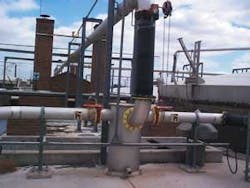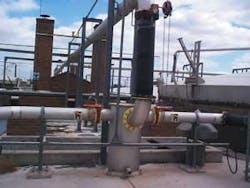Gas monitoring system maximises sludge digester performance
By Chris Dakin
Sixteen sludge digesters at Severn Trent Water's sewage treatment works in Minworth, near Birmingham, England, produce plenty of methane to power the site and sell to the National Grid. Currently, five engines produce in excess of eight megawatts from this source of renewable energy.
No accurate and reliable on-line system has been available to determine gas production from sites with more than one digester until Severn Trent introduced a fully automated sludge digester gas monitoring system at Minworth. Coventry-based Gas Data Ltd. designed and installed the system, which enables all of the gas performance criteria to be viewed on a dedicated page of the SCADA-based control system. The geographic overview shows the amount of gas being produced by each digester, giving an on-screen guide showing the percentages of:
• Methane, the prime energy source;
• Carbon dioxide, the main biogas;
• Oxygen, ideally a nil reading;
• Hydrogen sulphide (ppm), always present, but large concentrations are very harmful to the plant's engines.
"The main advantage of using Gas Data's system is that we can monitor gas quality, which is critical to the efficiency of the CHP engines", said Martin Dent, Severn Trent Water's senior engineer. "The LMS system very quickly highlights any deterioration in gas quality attributed to a specific digester, which enables the root causes to be identified and measures implemented to restore gas quality as soon as possible," he explained.
Serving each block of four digesters, a fixed position Gas Data LMS analyser samples gas in turn from each digester at 15-minute intervals - though at any time, the company can manually override. The analyser and all sample pipes are maintained with dry gas between samples, with the actual sample time taking only 30 to 60 seconds.
On the roof of the massive digester block at Minworth, each of the 16 Gas Data sampling points demonstrates another advantage of the new monitoring system. The hot, steamy gas (from sludge temperatures of around 37°C entering the sample point on the left hand side of the sampling tube is visible in its saturated state as it cools in the outside air, but whereas previously, sample lines would often become blocked, the new equipment allows condensation to be released, keeping the pipes dry and blockage-free. This is demonstrated by the crystal clear appearance of the sampling tube on the right hand side of the sampling point.
Gas Data completed its installation with the minimum of cabling to keep the four independent analysers as local as possible - although this still required 1.6 km of pipework.
Maximising the methane to power seven engines at the site involves a wide variety of sludge intakes. One of the sets of four digesters handles household/domestic (green route) sludge, whilst the other three sets of digesters process industrial sludge (including one block of the four digesters using sludge imported to the site). However, and particularly in the case of the industrial intake, there's never any certainty as to the exact quality of the sludge and its subsequent potential to produce high quantities of methane for energy use.
"In conjunction with our SCADA-based control, Gas Data's system removes any uncertainty over the quality, content and from which digester the varying levels of gas are being produced," added Martin Dent from Severn Trent Water. "Now, when gas levels change, we can see immediately which of the 16 digesters is not producing sufficient gas. We can also keep an eye on hydrogen sulphide levels so that any unusually high levels containing harmful acids can be prevented from reducing the performance and lifetime of our engines."
Author's NoteChris Dakin is the director of Gas Data Ltd, based in Coventry, England.

